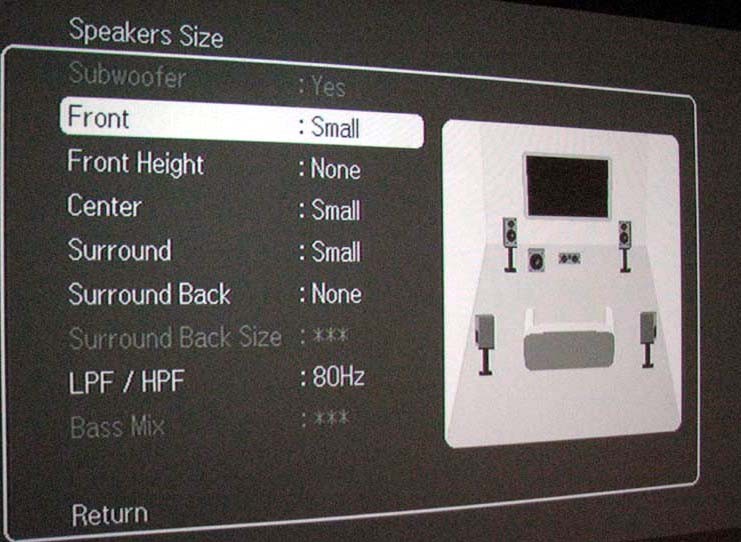AV Receiver Bass Management Basics – Settings Made Simple

This guide is designed to address the numerous questions we receive from new home theater owners who purchase a new system component and don’t quite understand the How’s and Why’s of bass management. More advanced home theater folks may wish to peruse our more in-depth guides available on the site that give a more thorough explanation of this complex and often misunderstood topic.
Properly configuring bass management, or the way your receiver handles low frequency information, is necessary for obtaining the best possible sound for your home theater system. There are several types of bass management systems that can exist.
What Is So Important About Bass Management?
Let’s say you bought a receiver and a speaker system. Bass management allows you to set them up in the most optimized way. Without it, you may not even hear the entire soundtrack to movies and music – it’s that important. In addition, speakers that are set incorrectly can often sound muddy or distorted because they are simply being sent too much frequency information that they cannot handle or process. Bass management is one of the most important setup procedures you can learn to tweak your system and make what you have sound even better – and for no cost!
In today's modern 5.1/7.1 home theaters, it is necessary to use at least one subwoofer to properly reproduce the LFE channel and to also reproduce the bass from all speakers set to "small". Using a subwoofer can provide deeper and more consistent bass than running your main speakers "large". It also frees up your speakers to produce the frequencies they were designed to, thus allowing you to play them louder with less distortion.
What is a Crossover Frequency, Anyway?
Before you can understand bass management it’s important to comprehend the terminology and the nomenclature behind the things we’ll be discussing. The crossover frequency is the point at which bass management kicks in, sending low frequency information to the subwoofer, and allowing the information above this frequency to continue to play out of the loudspeakers (more on this in our next section.) In effect, you are attempting to set this frequency to the lowest point at which your smallest speakers can play with authority (+/-3dB). If you have small satellite speakers with 4 or 5” woofers this will likely be around 100-120Hz. If you are using bookshelf speakers, this could be from 60-100Hz. For floorstanding speakers utilizing multiple woofers, this could be anywhere from 40Hz-80Hz, though we’ll give you some suggestions later that may have you setting this to 80Hz for all but satellite systems.
Large, Small – Am I Ordering Food or What?
In addition to setting the correct crossover frequency, determining whether your speakers are LARGE or SMALL is likely the most critical aspect to getting the best sound reproduction in your system. The majority of home theater novices we’ve met have their speakers set to all LARGE (if this is you please read on.) This great “mystery” is actually quite easy to understand if you know what’s happening behind the scenes. When you set a loudspeaker to LARGE, you are in effect telling the bass management to bypass that speaker and send it the full range of that channel’s information. Let’s slow down and think about this for a minute because I’ve actually met people that argue with me that their bookshelf speakers sound better set to LARGE.
If a bookshelf loudspeaker has an effective frequency response of 50Hz – 20kHz +/-3dB that means that information below 50Hz isn’t well produced by the speaker. In fact, it only serves to provide distortion and compression in the form of signal sent to the driver that it simply cannot reproduce. It’s like giving toffee to a person with no teeth! Let’s picture this in a practical example of an underwater explosion on screen. In this scene there is a large (read: loud) amount of 25-40Hz content and all of it gets sent to the bookshelf speaker. What happens? The speaker struggles with the information and plays back what it can, all the while being somewhat negatively affected by fact that it is also receiving content it simply cannot handle. Where is that 25-40Hz content being heard? Nowhere. It doesn’t get sent to the subwoofer, and it cannot be reproduced by the speaker.
Now, what happens when we set that same speaker to SMALL? Well, assuming we set the crossover frequency to, say, 80Hz, that bookshelf is absolutely loving life since it is now using all of its supplied amplifier power to deliver a relatively easy workload of frequency information. Reduced signal 80Hz is being sent to the speaker making it less stressed and resulting in less overall distortion.
Where Does All That Missing Sound Go?
OK, so we set the bookshelf or satellite speakers to SMALL – what happened to that content? Good question – easy answer. It got routed to the subwoofer channel where it belongs.
OK, I Get It But My Speakers Really Are LARGE!
For some, your main speakers may actually extend down to 30Hz or lower, especially if they include 10” or 12” side-firing low frequency drivers. The temptation will be to set these speakers to LARGE. The setting is there so there must be a place for its use, right? Actually, we usually recommend setting almost all speakers to SMALL, even if they are physically large floorstanding speakers. Here’s why: Even though those floorstanders have a low extension, they won’t necessarily go down to the lowest range of your subwoofer as linearly and free of compression (unless your main speakers have more piston area and box volume than your sub – but we won’t address that here) The problem with the LARGE setting is: the ultra low frequency information will not be heard if the speaker cannot reproduce it. Well if by some chance you were able to get your main speakers bass extension flat down to 20Hz, then adding the subwoofer on top of that would yield too much (up to 6dB) of bass output at the frequencies both are producing. Hence integration between the loudspeakers and subwoofer will be poor and the bass may be overpowering, sloppy and/or boomy.
As a practical example, my reference system has a pair of RBH Sound 1266-LSEs which extend down to 32Hz. I have them set to SMALL and I set my crossover frequency to 60Hz. Because of this, the subwoofer handles everything up to 60Hz that would otherwise go to my front speakers. The front speakers are now freed up to concentrate on only 60Hz and up. The result is no lost information, less distortion, more headroom and a better overall sound.
Alternatively, you can bi-amp your large tower speakers where the mid/tweet section gets connected to the receiver front main speaker level outputs which will be set to SMALL and you can connect the bass drivers to a separate powered amplifier to the sub output of your AV receiver. This will allow you to effectively treat them as powered subs which are now bass managed with your other powered subs in the system. However, this type of setup is more complex and you really need measurement tools and know-how to properly setup a multi-sub system to get the benefits that these type of systems offer.
That’s It, Go Tweak!
There’s a whole lot more to this topic, however we’ve fielded so many questions related to the basics that it seemed like a good idea to write a Bass Management Primer of sorts to really drive home how important these settings are to a system. Now that you know a little more about it we hope you’ll go to your receiver and re-check your settings to optimize your speakers and system to operate at its optimal potential. We highly recommend beginners making their lives a lot easier by setting ALL of their speakers to SMALL and using their AV receivers bass management (80Hz crossover) to route the bass info to a powered subwoofer. This will almost always give you the best results without having to resort to pulling out a measurement system, or a slide rule to optimize the performance.
